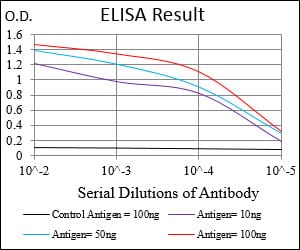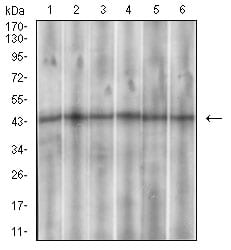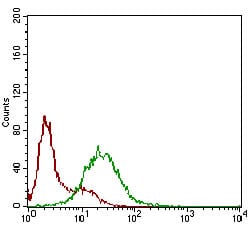


| WB | 1/500 - 1/2000 | Human,Mouse,Rat |
| IF | 咨询技术 | Human,Mouse,Rat |
| IHC | 咨询技术 | Human,Mouse,Rat |
| ICC | 技术咨询 | Human,Mouse,Rat |
| FCM | 1/200 - 1/400 | Human,Mouse,Rat |
| Elisa | 1/10000 | Human,Mouse,Rat |
| Aliases | SS3R; SS3-R; SS-3-R; SSR-28 |
| Entrez GeneID | 6753 |
| clone | 7H8E5 |
| WB Predicted band size | 45.8kDa |
| Host/Isotype | Mouse IgG1 |
| Antibody Type | Primary antibody |
| Storage | Store at 4°C short term. Aliquot and store at -20°C long term. Avoid freeze/thaw cycles. |
| Species Reactivity | Human,Rat |
| Immunogen | Purified recombinant fragment of human SSTR3 (AA: 1-43) expressed in E. Coli. |
| Formulation | Purified antibody in PBS with 0.05% sodium azide. |
+ +
以下是关于SSTR3抗体的3篇代表性文献的简要信息(注:文献标题和作者为示例性内容,具体文献需通过学术数据库查询):
---
1. **文献名称**: "Selective expression of somatostatin receptor subtype 3 (SSTR3) in Alzheimer's disease brain"
**作者**: Kumar, U., et al.
**摘要**: 本研究通过免疫组化技术结合SSTR3特异性抗体,发现阿尔茨海默病患者脑组织中SSTR3的表达显著下调,提示其可能与神经退行性病变的病理机制相关。
2. **文献名称**: "SSTR3 as a therapeutic target in gliomas: Antibody validation and clinical correlation"
**作者**: Patel, S.P., et al.
**摘要**: 文章验证了多种SSTR3抗体的特异性,并发现胶质瘤组织中SSTR3的高表达与患者预后不良相关,为靶向治疗提供了潜在依据。
3. **文献名称**: "Comparative analysis of SSTR subtype distribution in pancreatic neuroendocrine tumors using subtype-specific antibodies"
**作者**: Ben-Shlomo, A., et al.
**摘要**: 通过对比不同SSTR亚型抗体(包括SSTR3)的免疫反应性,揭示胰腺神经内分泌肿瘤中SSTR3的分布特征及其诊断价值。
---
**提示**:具体文献需通过PubMed、Web of Science等平台检索关键词(如"SSTR3 antibody"+"specific application领域"),并优先选择近5年、高被引或权威期刊的研究。
The somatostatin receptor subtype 3 (SSTR3) is a G protein-coupled receptor (GPCR) that binds somatostatin (SST), a neuropeptide regulating hormone secretion, cell proliferation, and neurotransmission. SSTR3. encoded by the *SSTR3* gene, is one of five known SST receptor subtypes (SSTR1-5) with distinct tissue distribution and signaling pathways. It is widely expressed in the central nervous system, pancreas, gastrointestinal tract, and certain endocrine tissues. Upon SST binding, SSTR3 primarily inhibits adenylyl cyclase via Gαi/o proteins, reducing intracellular cAMP levels, and may also modulate ion channels or MAPK pathways.
SSTR3 has gained attention for its role in neuroendocrine tumors (NETs), pituitary adenomas, and inflammatory conditions, where it is often overexpressed. Antibodies targeting SSTR3 are critical tools for research and diagnostics, enabling immunohistochemical detection of receptor expression in tissues. They also support therapeutic development, such as SST analog-based therapies or radiopharmaceuticals for targeted cancer imaging (e.g., PET scans) and treatment. Monoclonal SSTR3 antibodies are commonly used in Western blotting, immunofluorescence, and flow cytometry to study receptor localization, expression dynamics, and signaling mechanisms. Recent studies explore its potential in neurodegenerative diseases and metabolic disorders, highlighting its broader physiological relevance. However, challenges remain in specificity due to structural homology among SSTR subtypes, necessitating rigorous antibody validation. Overall, SSTR3 antibodies serve as vital reagents for unraveling receptor biology and advancing precision medicine approaches.
×